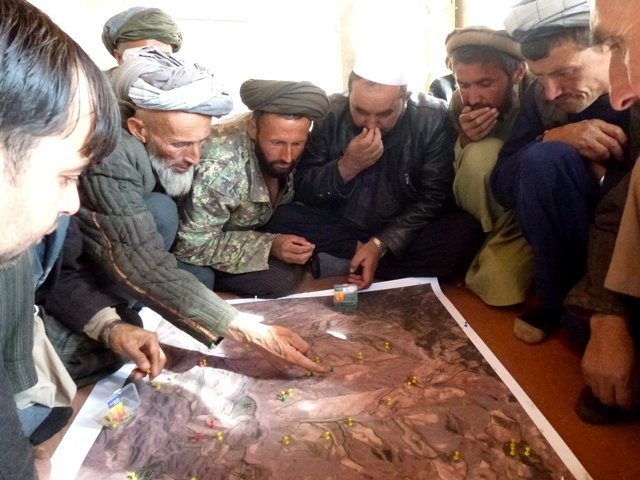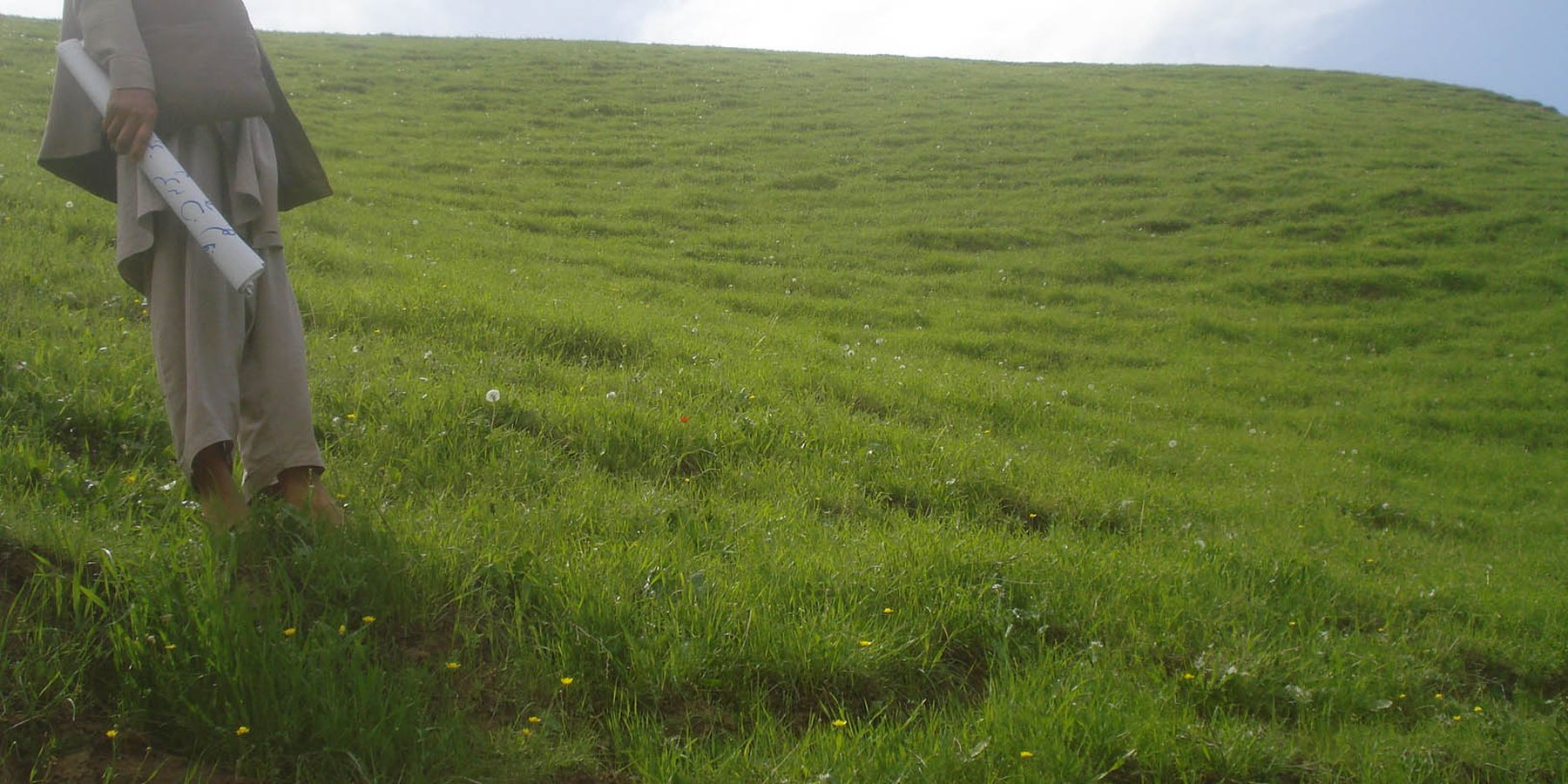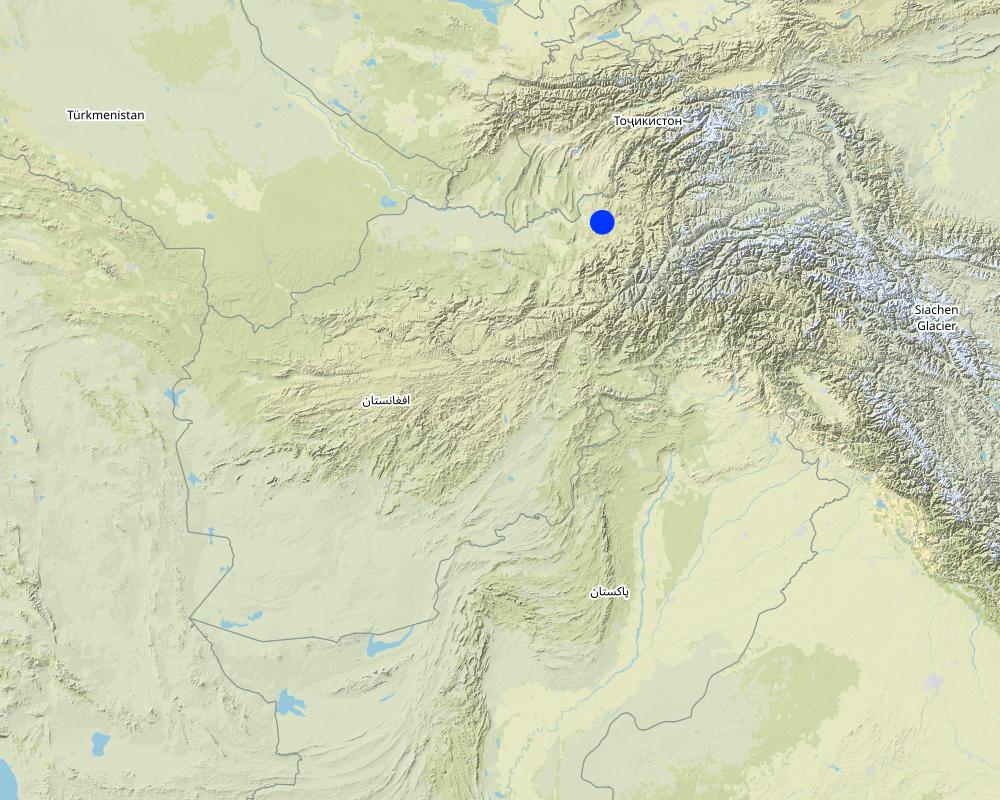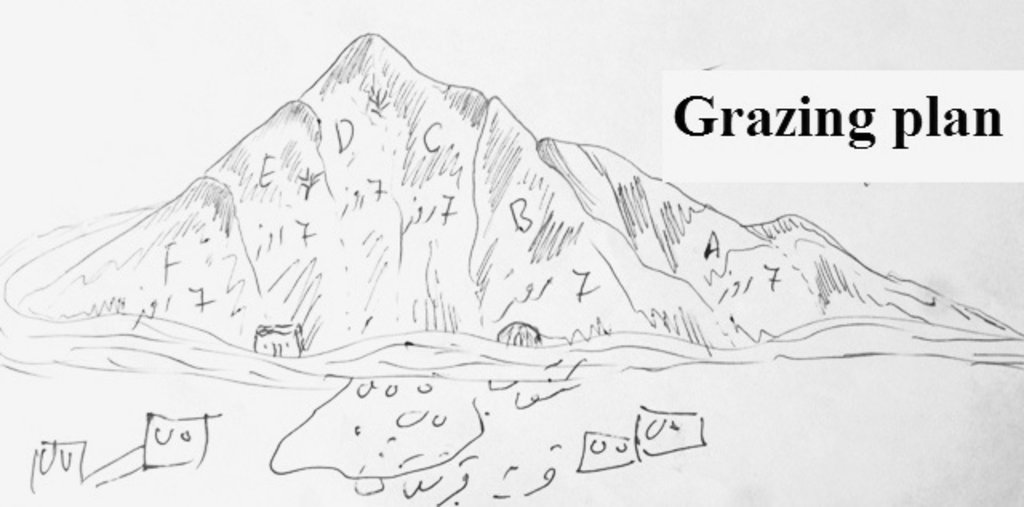Rotational grazing to restore degraded pastures [Afghanistan]
- Creation:
- Update:
- Compiler: Bettina Wolfgramm
- Editors: MIAJAN MAROOFI, Hekmatullah Sharifzai, Roziya Kirgizbekova, Aslam Qadamov
- Reviewer: William Critchley
Ploni ba navbat charonidani mol ba khotiri behbudi charogoh
technologies_671 - Afghanistan
View sections
Expand all Collapse all1. General information
1.2 Contact details of resource persons and institutions involved in the assessment and documentation of the Technology
SLM specialist:
Researcher:
Name of project which facilitated the documentation/ evaluation of the Technology (if relevant)
Livelihood Improvement Project Takhar, Afghanistan (LIPT)Name of project which facilitated the documentation/ evaluation of the Technology (if relevant)
Potential and limitations for improved natural resource management (NRM) in mountain communities in the Rustaq district, Afghanistan (Rustaq NRM Study)Name of the institution(s) which facilitated the documentation/ evaluation of the Technology (if relevant)
Terre des Hommes (Terre des Hommes) - SwitzerlandName of the institution(s) which facilitated the documentation/ evaluation of the Technology (if relevant)
Swiss Agency for Development and Cooperation (DEZA / COSUDE / DDC / SDC) - SwitzerlandName of the institution(s) which facilitated the documentation/ evaluation of the Technology (if relevant)
CDE Centre for Development and Environment (CDE Centre for Development and Environment) - Switzerland1.3 Conditions regarding the use of data documented through WOCAT
When were the data compiled (in the field)?
17/10/2016
The compiler and key resource person(s) accept the conditions regarding the use of data documented through WOCAT:
Ja
1.4 Declaration on sustainability of the described Technology
Is the Technology described here problematic with regard to land degradation, so that it cannot be declared a sustainable land management technology?
Nee
1.5 Reference to Questionnaire(s) on SLM Approaches

Watershed Associations (WSA) and Natural Resource Management Committees … [Afghanistan]
Two Watershed Associations (WSA), in Chaker and Nahristan watershed areas respectively, are registered at the national level with the Ministry of Agriculture Irrigation and Livestock (MAIL) and at the regional level with the Department of Agriculture. Both associations are strong, active, dynamic, and have the capacity to coordinate and support …
- Compiler: Bettina Wolfgramm
2. Description of the SLM Technology
2.1 Short description of the Technology
Definition of the Technology:
A plan for rotational grazing has been developed to control pasture use and prevent overgrazing of rehabilitated pastures.
2.2 Detailed description of the Technology
Description:
Livestock keeping is one of the key livelihood strategies in rural Rustaq, in addition to cultivation of cereals. Families rely on their livestock not only for consumption of meat from cattle, goats and sheep, and dairy products such as milk and sour milk, but also as means of transportation (donkeys), labour in agriculture (oxen, donkeys) and as a source of income through sales. Naturally, every family strives to increase their household’s livestock as much as they can, which increases the pressure on the local pastures - leading to extensive overgrazing. The pastures in Jawaz Khana and Sari Joy are characterized by poor vegetation cover, low carrying capacity and severe erosion with deep rills clearly visible. Heavy rains in spring and autumn wash off the topsoil on pastures, resulting in heavy erosion, landslides and gully formation. These severely degraded pastures continue to be used though "open access" - without any management schemes or regulations in place. Some pastures that are not suitable for grazing have been converted to arable lands and tree plantations. The quantity and quality of livestock fodder is insufficient for all the livestock, and this affects animal health.
Plans for rotational grazing were prepared for the communities in Sari Joy and Jawaz Khana to organize the use of local pastures and prevent their further degradation. Rotational grazing plans regulate the frequency and intensity of livestock grazing on the pastures. The area is seeded with alfalfa to improve the fodder stock and enhance the quality of the pasture. For up to three years the seeded area is closed to grazing, during which period the community is provided with stocks of hay and straw to feed their livestock as an alternative. After the end of the closure period, the grazing area is divided into 6-7 sections (paddocks) depending on the area of the pasture. The livestock graze the first paddock for 7 days and move to the next paddock. Each paddock is grazed for the period of 7 days during April and May. From the month of May the grazing area is closed for resting. The livestock move to the summer pastures for the rest of the summer months.
The community is key in preparing the grazing plans and identifying the pastures where these plans will be applied, as well as the conditions which are part of it, such as the frequency of the grazing period. Frequent meetings need to be held with the community livestock holders to explain the purpose of the rotational grazing and how it can be beneficial in pasture improvement. The Natural Resources Management Committee and the technical staff of the Livelihood Improvement Project (LIPT) are in charge of engaging the local pasture users to meet their needs and consider their views accordingly.
The actual implementation of the rotational grazing plans is difficult to assess for the time being. The grazing area is not fully restored and the fodder stock remains low. Many land users do not fully understand the concept behind the rotational grazing plans or their purpose. In an area where there is a severe shortage of livestock fodder and very limited grazing land, accepting and following these plans will require more time and additional support in terms of awareness-raising and support feeding of the livestock during the exclusion period. The villagers have some doubts about the costs and benefits of grazing and rotation. They have no full understanding of the benefits of the rotational grazing for their household and are likely to be not ready to adhere to such schemes.
Women are part of the livestock management system, and are in charge of feeding and taking care of the livestock. However, they are not aware about the plans for rotational grazing in their village and how are these plans are applied in practice.
2.3 Photos of the Technology
2.5 Country/ region/ locations where the Technology has been applied and which are covered by this assessment
Country:
Afghanistan
Region/ State/ Province:
Takhar Province, Rustaq District
Further specification of location:
Sari Joy and Jawaz Khana Villages
Map
×2.6 Date of implementation
Indicate year of implementation:
2015
If precise year is not known, indicate approximate date:
- less than 10 years ago (recently)
2.7 Introduction of the Technology
Specify how the Technology was introduced:
- through projects/ external interventions
Comments (type of project, etc.):
Livelihood Improvement Project in Takhar (LIPT) implemented by Terre des hommes (Tdh) Switzerland
3. Classification of the SLM Technology
3.1 Main purpose(s) of the Technology
- improve production
- reduce, prevent, restore land degradation
3.2 Current land use type(s) where the Technology is applied

Grazing land
Extensive grazing land:
- Semi-nomadism/ pastoralism
Intensive grazing/ fodder production:
- Improved pastures
Main animal species and products:
Cow, Sheep, Goat. Alfalfa
If land use has changed due to the implementation of the Technology, indicate land use before implementation of the Technology:
Some areas under the Technology are former croplands, which have been completely degraded and no longer suitable for crop cultivation.
3.3 Further information about land use
Water supply for the land on which the Technology is applied:
- rainfed
Number of growing seasons per year:
- 1
3.4 SLM group to which the Technology belongs
- pastoralism and grazing land management
3.5 Spread of the Technology
Specify the spread of the Technology:
- evenly spread over an area
If the Technology is evenly spread over an area, indicate approximate area covered:
- 0.1-1 km2
Comments:
6 ha
3.6 SLM measures comprising the Technology

management measures
- M2: Change of management/ intensity level
3.7 Main types of land degradation addressed by the Technology

soil erosion by water
- Wt: loss of topsoil/ surface erosion

soil erosion by wind
- Et: loss of topsoil

physical soil deterioration
- Pc: compaction

biological degradation
- Bc: reduction of vegetation cover
- Bq: quantity/ biomass decline

other
3.8 Prevention, reduction, or restoration of land degradation
Specify the goal of the Technology with regard to land degradation:
- restore/ rehabilitate severely degraded land
4. Technical specifications, implementation activities, inputs, and costs
4.1 Technical drawing of the Technology
4.2 Technical specifications/ explanations of technical drawing
After the end of the exclusion period the grazing area is divided into 6-7 sections (paddocks) depending on the area of the pasture. The livestock graze the first paddock for 7 days and move to the next paddock after 7 days. Each paddock is grazed for the period of 7 days during April and May. From the month of May the grazing area is closed for resting. The livestock move to the summer pastures for the rest of the summer months.
4.3 General information regarding the calculation of inputs and costs
Specify how costs and inputs were calculated:
- per Technology area
Indicate size and area unit:
1 ha
Specify currency used for cost calculations:
- US Dollars
Indicate exchange rate from USD to local currency (if relevant): 1 USD =:
67.0
Indicate average wage cost of hired labour per day:
5.2-5.3 USD
4.4 Establishment activities
| Activity | Type of measure | Timing | |
|---|---|---|---|
| 1. | Selection of the pasture area and awareness raising among people | Management | Fall |
| 2. | Leveling of the land | Agronomic | Fall |
| 3. | Sowing alfalfa seed | Agronomic | Spring |
| 4. | Site under quarantine | Management | Three years |
| 5. | Preparation of the grazing plan and community meetings | Management | Fall |
| 6. | Protection of the site during quarantine | Management | Three years |
4.5 Costs and inputs needed for establishment
| Specify input | Unit | Quantity | Costs per Unit | Total costs per input | % of costs borne by land users | |
|---|---|---|---|---|---|---|
| Labour | Leveling the land with a rake | person-day | 150.0 | 5.3 | 795.0 | 71.0 |
| Labour | Sowing alfalfa | person-day | 5.0 | 5.3 | 26.5 | 71.0 |
| Labour | Preparation of grazing plan | person-day | 2.0 | 9.0 | 18.0 | |
| Labour | Protection of the site | year | 1.0 | 447.0 | 447.0 | 100.0 |
| Equipment | Shovel | piece | 1.0 | 3.8 | 3.8 | 100.0 |
| Equipment | Rope | Meter | 50.0 | 0.15 | 7.5 | 100.0 |
| Equipment | Rake | piece | 1.0 | 3.0 | 3.0 | 100.0 |
| Plant material | Alfalfa seed | kg | 17.5 | 0.42 | 7.35 | |
| Fertilizers and biocides | DAP | kg | 125.0 | 0.9 | 112.5 | |
| Fertilizers and biocides | Urea | kg | 125.0 | 0.45 | 56.25 | |
| Total costs for establishment of the Technology | 1476.9 | |||||
If land user bore less than 100% of costs, indicate who covered the remaining costs:
Livelihood Improvement Project Takhar (LIPT) implemented by Terre des hommes (Tdh) Switzerland
4.6 Maintenance/ recurrent activities
| Activity | Type of measure | Timing/ frequency | |
|---|---|---|---|
| 1. | Community agrees to leave the pasture for resting/ exclusion | Management | Three years |
| 2. | Rotational grazing | Other measures | Spring/week/grazing plot |
| 3. | Reseeding alfalfa | Vegetative | After 5 years |
| 4. | Protection of the site | Management | Three years |
4.7 Costs and inputs needed for maintenance/ recurrent activities (per year)
| Specify input | Unit | Quantity | Costs per Unit | Total costs per input | % of costs borne by land users | |
|---|---|---|---|---|---|---|
| Labour | Reseeding alfalfa | person day | 5.0 | 5.3 | 26.5 | 100.0 |
| Labour | Protection during exclusion | year | 2.0 | 447.0 | 894.0 | 100.0 |
| Plant material | Alfalfa seed | kg | 17.5 | 0.42 | 7.35 | 100.0 |
| Total costs for maintenance of the Technology | 927.85 | |||||
Comments:
Costs calculated for a Technology area of 1ha was only done for the purpose of the WOCAT documentation. In reality SLM plots are on average 0.4 ha or 2 jiribs. Costs were simply multiplied by 2.5. The actual costs for a 1ha plot might be slightly different.
4.8 Most important factors affecting the costs
Describe the most determinate factors affecting the costs:
Due to the remoteness of the villages where the technology has been implemented, all the inputs for establishment, such as agricultural equipment, plant material, fertilizers, etc., are purchased in Rustaq town. The expenses for traveling and delivering the inputs affect the establishment costs.
5. Natural and human environment
5.1 Climate
Annual rainfall
- < 250 mm
- 251-500 mm
- 501-750 mm
- 751-1,000 mm
- 1,001-1,500 mm
- 1,501-2,000 mm
- 2,001-3,000 mm
- 3,001-4,000 mm
- > 4,000 mm
Specifications/ comments on rainfall:
Average annual precipitation for the area was calculated with 580 mm, with minimum in dry years (2000 and 2001) of 270 mm and maximum in wet years (2009/2010) of 830 mm. The absolute maximum rainfall was calculated for 1986 with 1024 mm. The data series covers the period from 1979 to 2014.
Agro-climatic zone
- semi-arid
5.2 Topography
Slopes on average:
- flat (0-2%)
- gentle (3-5%)
- moderate (6-10%)
- rolling (11-15%)
- hilly (16-30%)
- steep (31-60%)
- very steep (>60%)
Landforms:
- plateau/plains
- ridges
- mountain slopes
- hill slopes
- footslopes
- valley floors
Altitudinal zone:
- 0-100 m a.s.l.
- 101-500 m a.s.l.
- 501-1,000 m a.s.l.
- 1,001-1,500 m a.s.l.
- 1,501-2,000 m a.s.l.
- 2,001-2,500 m a.s.l.
- 2,501-3,000 m a.s.l.
- 3,001-4,000 m a.s.l.
- > 4,000 m a.s.l.
5.3 Soils
Soil depth on average:
- very shallow (0-20 cm)
- shallow (21-50 cm)
- moderately deep (51-80 cm)
- deep (81-120 cm)
- very deep (> 120 cm)
Soil texture (topsoil):
- medium (loamy, silty)
Soil texture (> 20 cm below surface):
- coarse/ light (sandy)
- medium (loamy, silty)
Topsoil organic matter:
- low (<1%)
If available, attach full soil description or specify the available information, e.g. soil type, soil PH/ acidity, Cation Exchange Capacity, nitrogen, salinity etc.
Local land users differentiate between the following soil types where the technology is implemented:
- Red: shallow; texture medium, coarse; low organic matter
- Light: moderately deep; texture medium; medium, low organic matter
5.4 Water availability and quality
Ground water table:
5-50 m
Availability of surface water:
medium
Water quality (untreated):
good drinking water
Is water salinity a problem?
Nee
Is flooding of the area occurring?
Ja
Regularity:
episodically
Comments and further specifications on water quality and quantity:
Floods occur mainly during the rainy seasons in spring and autumn. Availability of surface water differs for the villages of Sari Joy and Jawaz Khana. Sari Joy has good surface water availability. Jawaz Khana has poor water availability as water has to be fetched from a stream lower down.
5.5 Biodiversity
Species diversity:
- low
Habitat diversity:
- low
5.6 Characteristics of land users applying the Technology
Sedentary or nomadic:
- Semi-nomadic
Market orientation of production system:
- subsistence (self-supply)
Off-farm income:
- less than 10% of all income
Relative level of wealth:
- poor
- average
Individuals or groups:
- groups/ community
Level of mechanization:
- manual work
Gender:
- men
Age of land users:
- middle-aged
- elderly
Indicate other relevant characteristics of the land users:
The land users in the area where the Technology is applied belong to the Uzbek ethnic minority group Qarluq.
Although the men are generally the main land users, women and children also take active part in the related work. The functions of men and women are clearly distinguished within Afghan society. At the same time within the family this division of work and functions also results in men and women working hand-in-hand. An improvement of the family’s livelihood situation is expected to positively affect all family members. While, it is recognized that the involvement of women is key in order to secure basic human rights for everyone, to achieve good governance, sustainable development, and to efficiently contribute to poverty reduction (SDC 2004), it is also clear that a context sensitive approach is of high importance.
Women in rural Afghanistan are involved in many production and income generating activities that contribute to the overall household income, however, very few women own resources such as land and livestock, and their income generating options are fewer in comparison to that of men.
5.7 Average area of land owned or leased by land users applying the Technology
- < 0.5 ha
- 0.5-1 ha
- 1-2 ha
- 2-5 ha
- 5-15 ha
- 15-50 ha
- 50-100 ha
- 100-500 ha
- 500-1,000 ha
- 1,000-10,000 ha
- > 10,000 ha
Is this considered small-, medium- or large-scale (referring to local context)?
- medium-scale
5.8 Land ownership, land use rights, and water use rights
Land ownership:
- communal/ village
Land use rights:
- communal (organized)
Water use rights:
- communal (organized)
Comments:
Those who own land and use water for irrigation are obliged to pay for the water. The payment is made both in kind and in cash to the Mirob - the person in charge of distributing water in the community. The amount of the payment varies from village to village.
5.9 Access to services and infrastructure
health:
- poor
- moderate
- good
education:
- poor
- moderate
- good
technical assistance:
- poor
- moderate
- good
employment (e.g. off-farm):
- poor
- moderate
- good
markets:
- poor
- moderate
- good
energy:
- poor
- moderate
- good
roads and transport:
- poor
- moderate
- good
drinking water and sanitation:
- poor
- moderate
- good
financial services:
- poor
- moderate
- good
6. Impacts and concluding statements
6.1 On-site impacts the Technology has shown
Socio-economic impacts
Production
crop production
fodder production
animal production
wood production
non-wood forest production
product diversity
production area
Ecological impacts
Water cycle/ runoff
surface runoff
Soil
soil loss
Biodiversity: vegetation, animals
Vegetation cover
6.2 Off-site impacts the Technology has shown
downstream flooding
downstream siltation
buffering/ filtering capacity
Comments regarding impact assessment:
These comments apply to 6.1 and 6.2:
- Socio-economic impacts: Individual SLM implementers were asked to rate the benefits from the technology. They were asked to indicate production increase of crops; fodder; animals; wood; non-wood forest products; increase in prduct diversity; or production area. The most important increase they rated with 3, the second most with 2, others with 1 point. Averages of the points given by all terrace implementers are reflected here.
- Similarly for the "ecological impacts" and on "off-site impacts": Individual SLM implementers were asked to rate the on-site and off-site impacts of the technology on water; soil; and vegetation. They were asked to indicate the strength of impacts with three, two or one points. Averages of the points given by all terrace implementers are reflected here.
- Socio-cultural impacts: This section is answered by the scientists, based on information collected during focus group discussions, and interviews conducted with persons from the 3 villages where the LIPT project implemented the technology.
6.3 Exposure and sensitivity of the Technology to gradual climate change and climate-related extremes/ disasters (as perceived by land users)
Climate-related extremes (disasters)
Meteorological disasters
| How does the Technology cope with it? | |
|---|---|
| local rainstorm | very well |
Climatological disasters
| How does the Technology cope with it? | |
|---|---|
| drought | well |
Comments:
SLM implementers from three villages were asked to jointly discuss and rate how much the SLM technology reduced the lands vulnerability to drought and local rainstorms. Only vulnerability to the most prevalent climate extremes (drought and local rainstorms) was discussed. SLM technologies were rated as reducing vulnerability poorly, well, or very well. The average points reflected here are from multi-criteria matrixes compiled in three villages where the SLM technology had been implemented.
6.4 Cost-benefit analysis
How do the benefits compare with the establishment costs (from land users’ perspective)?
Short-term returns:
very positive
How do the benefits compare with the maintenance/ recurrent costs (from land users' perspective)?
Short-term returns:
very positive
Comments:
SLM implementers from three villages were asked to jointly discuss and rate the SLM technologies short term (1-3 years) and long-term (10 years) return. As most of the technologies have only been implemented 1-2 years ago, it is too early to compare benefits to maintenance costs. Farmers have little experience so far on the actual benefits of the SLM technologies. The ratings are mostly based on expected benefits and not on actual benefits.
6.5 Adoption of the Technology
- single cases/ experimental
If available, quantify (no. of households and/ or area covered):
6 ha
Comments:
Rotational grazing plans are developed for common lands used by the whole village. There is one common grazing plan for each village.
6.6 Adaptation
Has the Technology been modified recently to adapt to changing conditions?
Nee
6.7 Strengths/ advantages/ opportunities of the Technology
| Strengths/ advantages/ opportunities in the compiler’s or other key resource person’s view |
|---|
| If implemented according to the plan and the pasture area is allowed to rest, the quality and quantity of the fodder will be enhanced. |
6.8 Weaknesses/ disadvantages/ risks of the Technology and ways of overcoming them
| Weaknesses/ disadvantages/ risks in the compiler’s or other key resource person’s view | How can they be overcome? |
|---|---|
| The land users have no full knowledge about the plans for rotational grazing and how they should be applied | Increase awareness raising among the land users |
7. References and links
7.1 Methods/ sources of information
- interviews with land users
Focus group discussions were organized to collect information from SLM implementers in Sari Joy and Jawaz Khana.
- interviews with SLM specialists/ experts
Close collaboration took place during the compilation of this material with the technical staff of the LIPT project in Rustaq.
- compilation from reports and other existing documentation
Information provided in the reports of Tdh LIPT Project in Rustaq served as an initial source of information during the preparatory phase and also solidifying the description of the technology and area of implementation. Other background papers on Afghanistan were referred to for general information on agriculture and natural resource management in Afghanistan.
7.2 References to available publications
Title, author, year, ISBN:
Guidelines for Focus Groups Discussions
Title, author, year, ISBN:
Methods section of the Rustaq NRM study
Links and modules
Expand all Collapse allLinks

Watershed Associations (WSA) and Natural Resource Management Committees … [Afghanistan]
Two Watershed Associations (WSA), in Chaker and Nahristan watershed areas respectively, are registered at the national level with the Ministry of Agriculture Irrigation and Livestock (MAIL) and at the regional level with the Department of Agriculture. Both associations are strong, active, dynamic, and have the capacity to coordinate and support …
- Compiler: Bettina Wolfgramm
Modules
No modules





